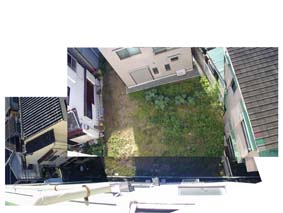 The awesome and ingenious Tokyo architecture firm Atelier Bow-Wow (the Japanese translation, Atelier Wan, sounds nicely like “1,” too) is keeping a blog of the combination house/studio they’re building for themselves in Naka Meguro, a central, dense, and expensive section of Tokyo. The lot they found was affordable only because it’s tiny and enclosed on all sides. Still, it’s zoned for more than 660 sqm, (including underground) of live/work space.
The awesome and ingenious Tokyo architecture firm Atelier Bow-Wow (the Japanese translation, Atelier Wan, sounds nicely like “1,” too) is keeping a blog of the combination house/studio they’re building for themselves in Naka Meguro, a central, dense, and expensive section of Tokyo. The lot they found was affordable only because it’s tiny and enclosed on all sides. Still, it’s zoned for more than 660 sqm, (including underground) of live/work space.
Because of their shape–a square-ish lot blocked in and invisible from the street, and connected to it by only a narrow passageway or easement–plots like this are called flagpole sites. The site poses just the kind of severe challenges that AB-W has specialized in addressing, though.
To fit their live/work program into the envelope of the building, they have integrated and jig-sawed the home and studio spaces together, and they seem to have managed to carve out incredible space, light, privacy, and even some views on a lot that looks like something out of a Gordon Matta-Clark exhibit. Of course, it’s all in Japanese, so good luck with that excite.co.jp translator…
House & Atelier Bow-Wow [via archinect]
Tokyo House: projects for flagpole, eel, and box sites
Category: architecture
Tropolism: I Read It For The Articles
Although the pictures are nice, too.
Turn-ons: urbanism, Meier’s third condo tower, Gluckman Mayner’s One Kenmare, long walks on sensitively adapted elevated railroad track parks, Gordon Matta-Clark exhibitions.
Turn-offs: Freedom Center squabbles, deceptively meaningless master plans, Gwathmey’s Sculpture for Living.
FSBO: 5-Sty TH, Vu, Loft-like space, Dbl Ht LR – MVRDV
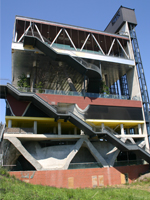
1ST TIME ON MKT!! Gdn! + outdr spc, [several, actually]Estate Cond. Nds TLC. EUR2.5M obo. Principals only.
EXPO-Tower – Pavillon der Niederlande [ebay.de, via archinect]
Klein Dytham’s Billboard Building
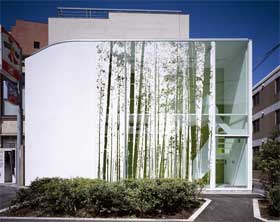 This new building is across the street from my in-law’s apt. in Tokyo, in the Minami Azabu neighborhood about 5-min. walk from Roppongi Hills.
This new building is across the street from my in-law’s apt. in Tokyo, in the Minami Azabu neighborhood about 5-min. walk from Roppongi Hills.
It just went up a few months ago, and the evening I went over to examine it close up, the young Japanese architect happened to be there with a photographer, taking pictures for the firm’s website. These pictures, in fact, at Klein Dytham.
The site used to be a tiny parking lot, he said, but then the road/sidewalk was widened, cutting into the lot. As you might expect, there’s a tiny little service core in the tapering end at left, but if there’s a basement, its entrance is well-hidden. Basically, what you see is what you get: a rare spec building with a strong architectural presence.
Now, one day back from Tokyo, just as I’m about to post this, I find that Regine has already scooped me on the building that I’ve been walking by almost daily for the last month.
Billboard House Moto Azabu [huh? klein-dytham]
Tokyo Snapshots, 2.1: Waketokuyama, by Kengo Kuma
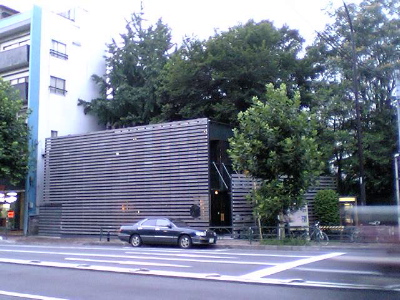
Near where we’ve been staying in Tokyo is this striking building, which I had to check out. The screen-like facade turns out to be cinder block-colored bricks set on end in a blackened steel frame. A meter back is the entry courtyard and the stark glass box of the restaurant, which feels suspended in the thick forest behind it. Of course, it’s on a busy corner of a major street (gaien higashi-doori, if you’re coming).
The restaurant is called Waketokuyama, and it’s apparently the Per Se of Tokyo, from the stunningly simple cuisine made with super-fresh ingredients, to the difficulties of getting a reservation. We’ll still look into eating there, but it was the architecture–by Kengo Kuma–which first caught my attention.
Kengo Kuma and Associates [kkaa.co.jp, such a big browser window for such little pictures]
Tokyo Snapshots, 1.4: Tadao Ando Ruins Omotesando
This is the Tadao Ando building complex that the ego-mad developer Mori Minoru is finishing on Omotesando, what was once the heart of alternative cultural Tokyo. With a slew of LVMH brand glass curtained flagships all around it, it should really complete the look.
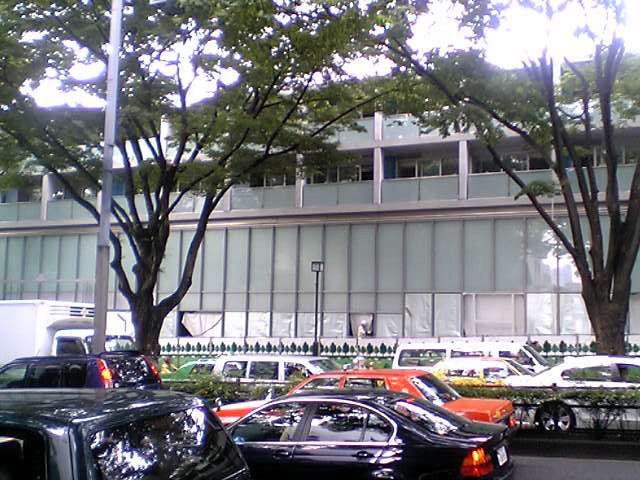
To: The Prada Hataz Crew
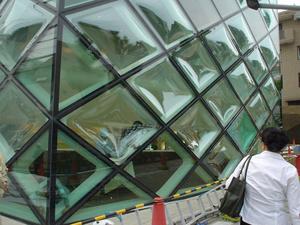 A report from the Herzog & deMeuron-designed Prada store in Tokyo’s Minami Aoyama neighborhood. I have some good news and some bad news.
A report from the Herzog & deMeuron-designed Prada store in Tokyo’s Minami Aoyama neighborhood. I have some good news and some bad news.
First the bad news. It was reported earlier that the store smelled like feet cat urine. It appears this is no longer the case. The white carpets seemed freshly–and repeatedly–shampooed, which may explain the lack of odor.
Also, I saw no evidence to support reports that the windows were cracking and popping out, and that the clothes were fading at an excessive rate.
Worst of all, it’s actually quite nice, much nicer than the Rem Koolhaas fiasco, anyway.
Now the good news: we were the only customers in the store during the entire time we were there. Also, the kid’s all-terrain stroller left calligraphic trails in the untrodden carpet.
Prada Tokyo images at Dezain.net
previously: “damn, but that company pisses me off.”
On Bullshit and The Getty
[2018 UPDATE: In 2018 The New York Times reports that five women who worked with Meier, either at his firm or as a contractor, have come forward to say the architect made aggressive and unwanted sexual advances and propositions to them. The report also makes painfully clear that Meier’s behavior was widely known for a long time, and that his colleagues and partners did basically nothing to stop it beyond occasionally warning young employees to not find themselves alone with him. This update has been added to every post on greg.org pertaining to Meier or his work.]
Michael Bierut’s excellent post on design bullshit has gotten a lot of attention. He starts by quoting the artist/gardner Robert Irwin, who hilariously calls bullshit on the man who would be king Of the Getty hill, architect Richard Meier, in a Getty-produced documentary, Concert of Wills. It’s a startling moment in what’s otherwise a typically institution-stroking hagiography of the “The travertine selected was from Michelangelo’s quarry” variety.
If it’s bullshit Irwin, wanted, Meier apparently thought, it’s bullshit he got. To demarcate where the architect’s work stops and the flaky artist’s landscaping starts, Meier created what is essentially a travertine toilet bowl to empty the placid fountains of his pristine, self-conscious Acropolis. It literally sounds like a giant is taking a pee. Forever.
It’s an at-once hilarious and unbelievably petty gesture. [And as I type this, I’d be even happier to find out the fountain was actually Irwin’s backhanded joke. As if he turned Meier’s bullshit into the fertilizer for his garden.] As it is, Irwin’s baroque landscape can’t defuse the rest of the Getty’s overbearing sense of self-importance.
Don’t get me wrong, I like it fine, and there’s some hand-rubbed plaster on some of those gallery walls I’d love to have myself. But I’ve always felt the ratio of building to art–of building to life–seemed wildly out of whack there.
It doesn’t help, of course, that on my first visit, I watched someone collapse in the main rotunda. With lightning efficiency, security guards hustled the portly man out of sight. They laid him on the ground behind one of the large stone benches at the entryway and radioed around frantically, while the man’s companions tried reviving him. Transfixed, I watched the scene for nearly 20 minutes as a circle of guards shielded the man–who turned out to have a heart condition–from view until the ambulan–oh, wait, that’s not an ambulance, that’s a Getty security van they’re loading him into. They’re not letting the ambulance up the hill, they’re shuttling him down to it.
I made a note to myself then not to die in a mausoleum. Well. That’s a cheery way to start the day. Have a great weekend!
Architecture: In The Gutter
Lockhart Steele, of the real estate blogging empire Steeles, has put architects in their place: The Gutter, a new sub-blog of Curbed.
“Ill-mannered commentary on the architectural arts” [gutter.curbed.com]
Why is this Calatrava Moment different from all other Calatrava Moments?
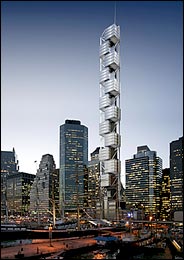 According to the Curbed Theory of NY Media Darling Architects, full-force Calatrava-hatin’ should’ve kicked in in January. But here it is April, and there’s a snuggly celebration in the Times by Robin Pogrebin, and it’s got subtexts packed so tight, I can’t figure out what the real story is:
According to the Curbed Theory of NY Media Darling Architects, full-force Calatrava-hatin’ should’ve kicked in in January. But here it is April, and there’s a snuggly celebration in the Times by Robin Pogrebin, and it’s got subtexts packed so tight, I can’t figure out what the real story is:
It’s what New York’s all about, baby: reinvention “he considered himself more an artist than an architect.” Really? Because he used to be “the bridge guy, the engineer who also did architecture.”*
Can you believe it, he’s in a museum show! In NYC!: True, Sandy does have a show coming up at the Met six months from now. Odd that there’s no mention of his MoMA shows, either last year’s “Tall Buildings” or that little ol’ one-man show in 1993. Or the Municipal Art Society’s St John the Divine exhibit that debuted his first NYC project.
$45 million condos at the Seaport don’t sell themselves, pal: I think we’re getting warmer. Says connoisseur/condo developer Frank Sciame, “Standing there in front of his sculpture, that’s how this started.” Or as he puts it in Absolute magazine, “In addition to being a work of art… it will also be a place to live.”
He’s the only thing right about the WTC site: Ah-ha. “It helps us immensely to have someone give us a solution that is workable from an engineering point of view, as opposed to just an architecturally beautiful feature.” Translation: Thanks for playing, Danny. There are some lovely parting gifts for you on the way out.
See, if only we’d let the Port Authority make every redevelopment decision for the WTC site unilaterally, we’d be much better off. Ahh, I’m inspired already.
An Architect Embraces New York [nyt]
Calatrava’s Tower: Even More Egregiously Expensive! [curbed]
* like the suit who calls himself a filmmaker but ends up writing all the time has room to talk.
Walker Art Center Production Blog
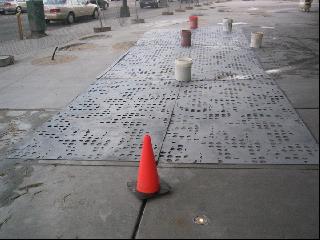 So the Walker Art Center reopened last week in Minneapolis, and the reviews I’ve seen are great.
So the Walker Art Center reopened last week in Minneapolis, and the reviews I’ve seen are great.
Did you know they had what amounts to a production blog for the completion of the new Herzog & deMeuron addition? Titled “New Media Initiatives,” there are entries about architectural minutiae like sandblasting H&deM patterns on the new sidewalk, testing semi-reflective films for the projected signage, and kiosks. Lots of kiosks. Solid, geeky museum stuff. There’s also an education-related blog.
New media initiatives [blogs.walkerart.org, via man]
Torqued Eclipse*
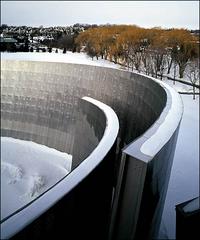
“Ms. Luce gave the design team at Nissan a steel wall to hide works in progress.”
And then Mr Serra gave Ms. Luce and the design team at Nissan a good legal shellacking.
Architecture and Carchitecture [nyt]
* I KNOW, it’s Mitsubishi. Come up with a good hed using a Nissan model, and I’ll change it.]
This is your brain on Gehry. Any Questions?
Since it was opened, the polished stainless steel roof on Frank Gehry’s Disney Concert Hall in LA has been throwing off so much glare, people are getting baked alive in the neighboring condominiums. And on the street, fuggedaboutit. They’re frying eggs and dog’s brains on the sidewalk.
The result: the County Board of Supervisors has ordered a bunch of workers with hand sanders to climb up there and dull the thing down a bit. Meanwhile, some tourist from New Jersey, 3,000 miles away, thinks they should leave it alone.
Disney Concert Hall to lose some luster [LAT, via BoingBoing]
Related: Frank Lloyd Wright’s Ennis-Brown house was “red-tagged,” meaning no one can enter it, after a inspectors noticed a rainsoaking-related shift in a retaining wall. [LAT, via archinect]
Saint Burns Philip Johnson at Stake
Philip Johnson called himself a whore, partly to diffuse critics who didn’t like his constantly changing style or his intense curiousity in pursuit of new architectural ideas.
Apparently, though, it didn’t save him from an eviscerating obituary in the Guardian at the hands of Andrew Saint. Unlike Homer Simpson–who likes his beer cold and his homosexuals flaming–this venal Cambridge architecture professor prefers his beer warm and his homosexuals safely confined to those four years of British public school, thank you very much. At least that’s what the whole obituary is about.
Saint’s acid conflation of the evils of gayness, inherited wealth, corporations, aesthetics, modernism and Nazism was enough to drive archinect’s Javier Arbona to the typewriter to call Saint to repentance.
Philip Johnson: Flamboyant postmodern architect whose career was marred by a flirtation with nazism [Guardian]
A response to Andrew Saint, by Javier Arbona [archinect]
[update: In a NYT op-ed, Mark Stevens says basically the same thing as Saint, but with more quotes and less gay.]
Robert Polidori: ‘Habitats, Not Architecture’
Check out Michael Bierut’s appreciation of the bracing architecture environment photographs of Robert Polidori. Polidori’s are not photos for architects, who want their buildings to look their renderings–pristine and perfect, unsullied by unpredictable humanity and the less-pedigreed landscape surrounding them. No, Polidori makes photos that seem real; when you go to Bilbao, it’d actually look–and feel–like his picture, not the postcard. His work appears often in The New Yorker, Architecture Week, and in his books (actually, it appears all the time in his books).
Robert Polidori’s Peripheral Vision [designobserver.com]
Book Review: Polidori’s Metropolis [metropolismag.com]
Buy Robert Polidori’s Metropolis for 65 undiscounted bucks at Amazon.
